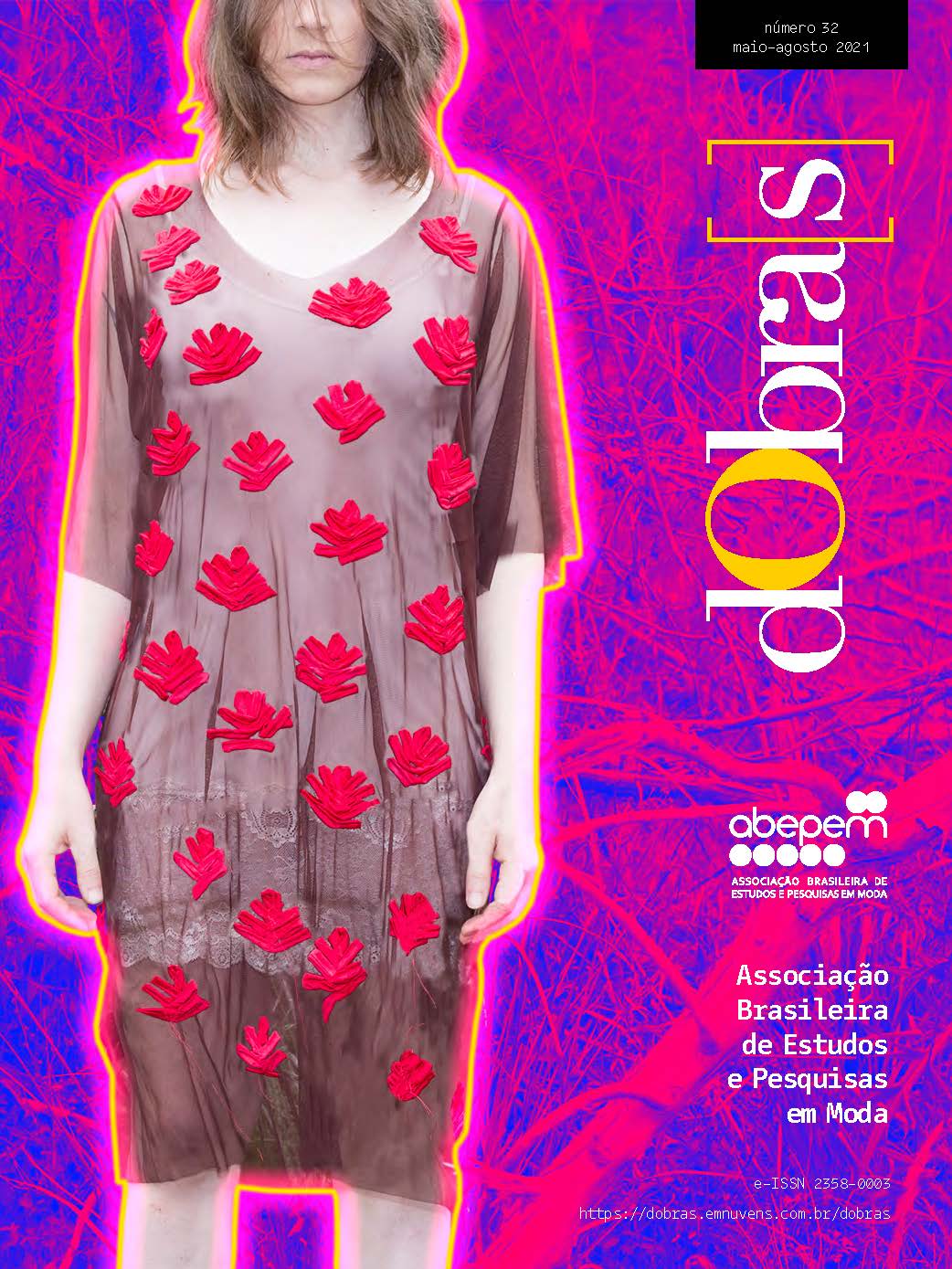Snake
ornament that transcends the materiality of jewelry
DOI:
https://doi.org/10.26563/dobras.i32.1375Keywords:
Ornament, Adornment, Jewel, Imaginary, Snake’s sensesAbstract
The article intends to foster a reflection on the possible meanings of the image of the snake associated with the creative constructions of ornaments associated with jewelry. Through the thoughts of the French philosopher Gilbert Durand (2012), this research starts from the understanding of the relevance of the snake in the human imagination, highlighting its presence as a timeless ornament in jewelry since the Egyptians, passing through the Greco- Roman mythology, your protagonism in the artistic movement Art Nouveau; and, finally, as a striking element in the so-called high jewelery in the 21st century. According to Durand, the imaginary is related to the extensive individual and collective capacity to give meaning to the world, having the symbol as a way to express it. The studies also include Bourdieu’s meditations (1989) on symbolic power; and the ideas of Ernst Hans Josef Gombrich (2012) for the understanding of the construction of the ornament in the composition of the jewel as an adornment, in addition to the defense for the autonomy of design in the creative process. The brief tour of the important imaginary references of the snake recognized throughout human history culminates in a reflective and practical proposal for the development of a jewel adornment. The author then takes the serpent as an ornament for the realization of a creative exercise with the proposal to conceive an ornament inspired by the ophidic image as the main element for the development of a jewel.
Downloads
References
ARAÚJO, Alberto; TEIXEIRA, Maria Cecília. Gilbert Durand e a pedagogia do imaginário. Letras de hoje, v. 44, n. 4, p. 7-13, out./dez. 2009.
BÍBLIA. Bíblia Sagrada: Edição de Estudos. São Paulo: Ave-Maria, 2019.
BLOG CAROLINE RIBEIRO. Vogue Brasil HStern Primavera/Verão. Disponível em: http:// blogcarolineribeiro.blogspot.com/2010/10/vogue-brasil-hstern-primaveraverao.html. Acesso em: 27 jun. 2019.
BONEWITZ, Ronald Louis. Gemas e pedras preciosas. Trad. Lizandra Magon de Almeida. Barueri: Disal, 2013.
BOURDIEU, Pierre. O poder simbólico. Trad. Fernando Tomaz. Rio de Janeiro: Editora Bertrand Brasil S.A, 1989.
BVLGARI. Bvlgari Heritage Icons. Disponível em: https://www.bulgari.com/pt-br/bulgariheritage- icons. Acesso em: 28 jun. 2019.
BVLGARI, Bvlgari Magazine Oscar 2019. Disponível em: https://www.bulgari.com/pt-br/ magazine/oscar-2019. Acesso em: 28 jun. 2019.
BVLGARI. Bvlgari Portfolio. Skira, 2013.
CAMUS, Albert. O homem revoltado. Trad. 9. ed. Rio de Janeiro: Record, 2011.
CASA-MUSEU MEDEIROS E ALMEIDA. Esmalte Cloisonné Chinês – Destaque Dezembro 2013. Disponível em: https://www.casa-museumedeirosealmeida.pt/pecas/cloisonnechines- destaque-dezembro-de-2013/. Acesso em: 18 jun. 2021.
CHEVALIER, Jean; GHEERBRANT, Alain. Dicionário de símbolos: mitos, sonhos, costumes, gestos, formas, figuras, cores e números. Colab. André Barbault; coord. Carlos Sussekind; trad. Vera da Costa e Silva. 6. ed. Rio de Janeiro: José Olímpio, 1992.
DE OLIVEIRA, Poliana Conceição. René Lalique: a joia como simbologia. 2015. 104 f. Monografia (Especialização em Moda, Cultura de Moda e Arte) – Universidade Federal de Juiz de Fora, Juiz de Fora (MG), 2015.
DURAND, Gilbert. As estruturas antropológicas do imaginário: introdução à arquetipologia geral. Trad. Hélder Godinho. 4. ed. São Paulo: WMF Martins Fontes, 2012.
FAUNA E FLORA DO RN. Cobra verde philodryas olfersii. Disponível em: http:// faunaefloradorn.blogspot.com/2015/07/cobra-verde-philodryas-olfersii.html. Acesso em: 27 jun. 2019.
FUNDAÇÃO CALOUSTE GULBENKIAN. Peitoral serpentes. Disponível em: https://gulbenkian. pt/museu/works_museu/peitoral-serpentes/. Acesso em: 27 jun. 2019.
GALLERIE DEGLI UFFIZIE. Medusa Caravaggio. Disponível em: https://www.uffizi.it/en/ events/caravaggio-and-the-17th-century. Acesso em: 26 jun. 2019.
GOOGLE IMAGENS. Acesso em: 29 jun. 2019.
GOMBRICH, Ernst Hans. O sentido da ordem: um estudo sobre a psicologia da arte decorativa. Trad. Daniela Pinheiro Machado Kern. Porto Alegre: Bookman, 2012.
HERPETOFAUNA. Curiosidades sobre as cobras. Disponível em: http://www.herpetofauna. com.br/Curiosidades_sobre_as_cobras.htm. Acesso em: 27 jun. 2019.
HSTERN. Coleções Ancient America. Disponível em: https://www.hstern.com.br/ colecoes/ancient-america. Acesso em: 27 jun. 2019.
HUXLEY, Aldous. As portas da percepção; céu e inferno. Trad. Marcelo Brandão Cipolla; Thiago Blumenthal. 1. ed. São Paulo: Biblioteca Azul, 2015.
JONES, Owen. A gramática do ornamento: uma rara coleção de mais de 2.350 padrões clássicos. Trad. Alyne Azuma. São Paulo: Editora Senac, 2010.
LALIQUE. Lalique. Disponível em: https://www.lalique.com/. Acesso em: 1° ago. 2018.
LOOS, Adolf. Ornamento e crime. Trad. Lino Marques. Lisboa: Edições Cotovia Ltda, 2004.
MALLARMÉ, Sthéphane. Joias Bijoux. La dernière mode: gazette du monde et de la famille. Trad. Izabel Haddad. Rev. Márcia Bandeira. Paris: Editions Ramsey, 1874.
MONNERYON, Frédéric.; RENARD, Jean-Bruno.; LEGROS, Patrick.; TACUSSEL, Patrick. Sociologia do imaginário. Trad. Eduardo Portanova Barros. 2. ed. (Coleção Imaginário Cotidiano). Porto Alegre: Sulina, 2014.
MUSEU CALOUSTE GULBENKIAN. Sala René Lalique. Disponível em: https://gulbenkian. pt/museu/sala-rene-lalique/. Acesso em: 17 jun. 2021.
NATIONAL GEOGRAFHIC. Coroa de Tutancâmon. Disponível em: https://br.pinterest.com/ pin/619878336183345245/. Acesso em: 29 maio 2020.
PAIM, Gilberto. A beleza sob suspeita: o ornamento em Ruskin, Lloyd Wright, Loos, Le Corbusier e outros. Rio de Janeiro: Jorge Zahar Ed., 2000.
PAREYSON, Luigi. Estética: teoria da formatividade. Trad. Ephraim Ferreira Alves. Petrópolis: Vozes, 1993.
PASTOUREAU, Michel. Os animais célebres. Trad. Estela dos Santos Abreu. São Paulo: Martins Fontes, selo Martins, 2015.
RIBEIRO, Maria Goretti. Imaginário da serpente de A a Z (Livro eletrônico). Campina Grande: EDUEPB, 2017.
SANTOS, Rita. Joias: fundamentos, processos e técnicas. São Paulo: Editora Senac, 2017.
SCHMUCKMUSEUM PFORZHEIM. Bracelete helenístico serpente. Disponível em: https:// www.schmuckmuseum.de/museum/die-sammlung-zeigt-schmuckkunst-aus-fuenfjahrtausenden. html?cont=1&cHash=4fa19b3c5d079f4febb5562624486a0a. Acesso em: 21 jun. 2021.
SIMMEL, George. Filosofia da moda e outros escritos. Trad. Artur Morão. Lisboa: Texto&Grafia, 2008.
Downloads
Published
How to Cite
Issue
Section
License

This work is licensed under a Creative Commons Attribution-NonCommercial-ShareAlike 4.0 International License.
The copyrights of the works published in this journal belong to the author, and dObra[s] holds the rights of first publication. Due to their publication in this open access journal, any work here is free to use, with its own attributions, in educational and non-commercial applications.










